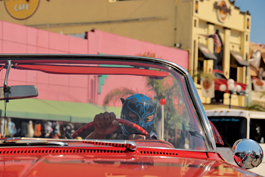home | metro santa cruz index | features | santa cruz | feature story

Because Promptness Is A Virtue : Extreme Tiger heads to an appointment.
Get a Grip
UCSC filmmaker Gustavo Vazquez and his luchadores storm the 20th Pacific Rim Film Festival.
By RICHARD VON BUSACK
We've all heard of machismo, and yet the toughest men in Mexico must hide their faces. Take Mexico's answer to Superman: Santo. He was Rodolfo Guzman Huerta; in real life he had a half-century career and made 50 fictional movies (according to the excellent SantoandFriends.com website). And when Santo's mighty heart gave out, he was buried with the silver mask on. Who knew? This great warrior, who put the hurt on so many mummies, witches and vampires, might face further battles after death. We gueros saw these films dubbed in by a chocolaty Irish baritone. Strange, beautiful artifacts they were, swimming on a wave of static on the high-numbered UHF channels.
Happily, lucha isn't dead. Gustavo Vazquez, a professor at UCSC, brings his documentary Que Viva La Lucha to the Pacific Rim Film Festival. The documentary concerns the wrestling life in his hometown of Tijuana. Subjects include Extreme Tiger, the ever-raunchy Pancho Canchondo and Rey Misterio Sr., the uncle of the WWF star. The documentary captures the fever for what one witness claims is "the greatest wrestling in the world."
"I grew up in that world," says Vazquez, who appears in person at the Rio Theatre on Tuesday following his film's screening. He saw Santo and Mil Mascaras at an arena at the top of the hill where he lived. Tickets were 45 cents, about the same as a movie. "If you wanted you could get ringside seats for two to five dollars. But those were the worst seats. People threw things from the upper decks." It turned out that Vazquez had known Rey Misterio Sr. when he was young, never recognizing King Mystery in his secret identity as a man from the neighborhood.
The names have changed, but the old categories remain: rudos, the bad-guy wrestlers who blindside a heroic tecnico with a folding chair or an aluminum stepladder. There is also a subgenre of loud 'n' proud wrestling maricons (literally, "big Marys") called exoticos, perhaps analogous to the Yankee Gorgeous George of early 1950s brawling. (George survives in the modern memory thanks to the curly, perfumed "Ravishing Ronald" in the 1951 Bugs Bunny cartoon "Bunny Hugged.")
"Exoticos are more popular than ever," Vazquez says. "It's surprising, because of the macho public who start out yelling at them. But they're such good wrestlers, the crowd is won over, asking for kisses and photographs afterwards."
One interviewee in Que Viva La Lucha claims that masked wrestling in Mexico goes back to pre-Columbian times, with Indian warriors clad in animal masks. Vasquez says that there's not much evidence of pre-Columbian wrestling, except for an Olmec figure depicting a man in a wrestling crouch. There is proof that a wrestling exhibition entertained the ill-fated Emperor Maximilian in the 1860s. The first known masked wrestler, according to Vazquez, is an Irish tumbler of the 1930s; he was much hated, so he had to don a leather mask to perform.
"After that, he was loved," Vazquez says. "This is all about the transformative power of the mask, which Hollywood has lately offered up."
And like Spider-Man and his colleagues, there are real life heroes who have used the lucha traditions to effect change. The crimson-masked Superbarrio, a tenant's union leader, testified (with the mask on) at the Mexican Congress. Moreover the film Nacho Libre is based on the real-life career of Fray Tormenta, a priest who wrestled to benefit an orphanage.
"The real story is very sweet," Vazquez comments. "I think they missed that in the movie."
Some might mistake a scholarly interest in wrestling as nostalgia; this is but one side of Vazquez's art. He is a longtime experimental filmmaker who has an installation this year at the annual "Dias de los Muertos" exhibition at the Oakland Museum of California. The professor stresses that while he remains a fan, wrestling isn't the object of his obsession.
"My main interest isn't lucha as such," he says. "What's interesting to me is the idea of these people who have a double life, who might work in jobs where they're not valued. Through lucha they can achieve their dream of being part of a struggle of good and evil, or of being artists. It's like dancing, too, where any man or a woman can be a king or a queen."
QUE VIVA LA LUCHA screens Saturday, Oct. 18, at 7pm at the Cabrillo College Watsonville Center and on Tuesday, Oct. 21, at 3pm at the Rio Theatre, 1205 Soquel Dr., Santa Cruz (Gustavo Vazquez appears at Tuesday's screening). Free.

Suspendered Disbelief : Pat Morita is the editor of a failing newspaper and Sylvia Chang a writer in search of love in 'American Fusion.'
American Version
UCSC alum Frank Lin does sweet-not-sappy in a multiculti romantic comedy
By RICHARD VON BUSACK
I don't hate the USA, but bitter experience has made me wary of comedies with "American" in the title. (An American Carol is but one recent example of what you have to look out for.) However, former Santa Cruzan Frank Lin's spicy and salty American Fusion is one romantic comedy that isn't a romance first and a comedy second. The demure and mature female lead, the renowned actress/director Sylvia Chang, recalls Doris Day in her better movies, with her shy yearnings, a wardrobe of a lot of silk pajamas and a small lingerie scene. Wait, how to put it without sounding letchy? A lot of these post-My Big Fat [Your Ethnicity Goes Here] Wedding comedies are not only partially financed by the Old World grandparents, but also seem to have no adult material that might offend them.
Either Lin wasn't worried, or else he has earthy grandparents. In fact the former Santa Cruzan dedicates this movie to his grandmother. Via email, Lin notes that taking care of his own grandma for six months following back surgery gave him the idea for this movie. The bawdiness is the result of collaboration with the comedian Randall Park; this means an occasional vibrator peeking out of the frame, as well as out-and-out slapstick. "If I hit you, it means I love you" is one of the three rules of the family here.
Yvonne (Chang) is a divorced first-generation daughter, dreaming of a stud like Fabio (played, in fact, by the one and only Fabio). Lin comments, "When Fabio showed up, every woman on the set was literally screaming. By the end of the day, I think every girl had kissed him. He's very, very good at kissing women ... especially at making it look beautiful for the camera."
Sadly, Yvonne wakes from this dream of Fabio to the raspy nagging of her mother (Lang Yun). When a game of mahjong gets out of hand, her mother throws her back out. A surgeon recommends major back surgery, fast. Meanwhile, through her job writing advertorial for a local weekly, Yvonne meets a good-looking Chicano dentist (Esai Morales), a man her racist mother could never stand.
On the sidelines, a couple of Asian film icons get to go broad, and they seem to love it: the late Pat Morita is in goggle glasses and fright-toupee as the editor of Yvonne's tottering newspaper. Long-memoried James Hong fans cherish this actor's role as a Taoist wizard menacing Kurt Russell with "the Hell of the Upside-Down Sinners" in Big Trouble in Little China. As an arcane herbalist, Hong gets a line almost good, as he brandishes a murky jar: "Sea otter nipples!"
Lin takes care of the high and the low end of comedy before the bonding takes place at the end. "I didn't want American Fusion to be a heavy dramatic story," Lin comments. "I went through a very tough time with my family. We worried, we suffered, but in the end we found out we loved each other so much."
This is Lin's second film. His first was a feature-length martial arts parody called Stoned Fist that screened at the Porter Dining Hall, the culmination of his studies as a theater major with an emphasis on film studies. "I am so grateful I studied theater before jumping into film. Knowing the origin and history of storytelling has paid off tremendously," Lin notes.
Meanwhile, Lin has finished an unreleased horror film titled Hysteria and is also working on a film he can't talk about yet. As for American Fusion, it will be out on DVD around Chinese New Year 2009.
"In the end," Lin finishes, "I think we were able to pull off almost everything that was in the script. Of course more ideas have popped up in the editing room and after screenings--I think we're saving these up for another comedy."
AMERICAN FUSION screens Saturday, Oct. 18, at 8:30pm at the Cabrillo College Watsonville Center (Frank Lin appears in person) and Sunday, Oct. 19, at 3:30pm at the Del Mar, 1124 Pacific Ave., Santa Cruz. Admission is free.

The Bee's Knees : Filmmaker Sasha Friedlander performs the Balinese dance piece 'Oleg Tambulilingan,' roughly translated as 'The Bee and the Butterfly,' at the Tuesday screening of 'Dancing Into Bali.'
Island Fever
A childhood trip inspires a film on Balinese dance
By Traci Hukill
The documentary Dancing Into Bali may be just 15 minutes from beginning to end, but it was nearly two decades in the making. Sixteen years ago, at the age of 7, Sasha Friedlander visited Bali for the first time with her parents, Santa Cruz artists Sara and Cliff Friedlander. The experience was dazzling, and on their return to Santa Cruz Sasha started taking Balinese dance lessons from a local teacher as a way to maintain a connection to the island. Tall for her age and graceful, she had an aptitude for the precise movements of the dance, and by the time she was 8 she'd been invited to join the Bay Area's Gamelan Sekar Jaya, an honor that entailed driving to El Cerrito once a week for practice. This exercise in family dedication lasted 10 years, until Friedlander enrolled in UCLA's World Arts and Cultures program, where she got interested in film. This documentary represents her senior project.
When it came time to select a subject, there was really no question. Friedlander had toured Bali twice with Gamelan Sekar Jaya, appearing on national television and at temple ceremonies, and had continued studying Balinese and other dance forms at UCLA. She had also taken four years of Indonesian. So she packed her bags and headed back to Bali in search of young dancers to profile for her film. Two weeks into a month-and-a-half stay, she found three 8-year-olds: Ni Wayan Juliarnitu, the good-natured daughter of a poor family; the preternaturally mature Ni Kedek Ratna Yunita and the tiny but willful Ni Komang Indah Darayanti.
"These three stood out for me because of their skill level," says Friedlander, who's back in Santa Cruz for a visit before returning to Bali, where she now lives. They were also chatty. "I tried to do interviews with other girls in other [groups], and they wouldn't answer questions, or if they did they would all answer them the same. So after rehearsal, I pulled these three aside and asked them if they wanted to be interviewed, and they were blabbermouths!"
Twice a week for a month Friedlander filmed the girls dancing and interviewed them afterward. At the end of her stay she had 25 hours of video to fit into a 15-minute frame. Fortunately, she likes editing, and she does it well. The film is a well-paced, almost contemplative portrait of one facet of Balinese life, but like all such portraits, it offers a window into the greater culture--and a mirror to our own. To hear Ni Wayan Juliarnitu explain that "teachers are people who are very close in spirit to the dance" is to comprehend the stinginess of the aphorism "Those who can't, teach," and to see a Balinese teacher coaching his student in the traditional way--closely shadowing his step, manipulating his arms and torso--is to recognize that not every culture is suspicious of close physical contact between adult and child.
For the most part, Friedlander stays out of the picture, keeping her narrative to a few framing comments. Mostly the girls and their teachers do the talking, though not too much. There are many quiet pauses in this film. In one scene, two of the girls dance to the jangling, strangely melodic music of the gamelan. After they stop, a docile white dog wanders into the edge of the frame and a silence broken only by birdsong and the other sonic minutiae of life in the tropics. It's a lovely scene, one well worth dancing about.
DANCING INTO BALI screens Tuesday, Oct. 21, at 7pm at the Rio Theatre, 1205 Soquel Ave., Santa Cruz, followed by Sasha Friedlander's performance of a Balinese dance. Admission is free.

Miss Incarcerated : A beauty contest at a women's prison gets the inmates all riled up in 'La Corona.'
Rim Shots
The 20th Pacific Rim Film Fest is a chance to travel thousands of miles, absolutely free
By Richard von Busack
Pacific by name, nonspecific by nature, the 20th annual free Pacific Rim Film Festival began as a series concerning Hawaii and now encompasses films from Korea to Colombia. Highlights this year are:
The touching and intelligent La Corona. Annually, the main woman's prison in Bogota hosts a beauty pageant, and directors Amanda Micheli and Isabel Vega are on hand to watch the rivalries between cell blocks. The two had first-rate access to the contenders among the inmates: Angela, a robber with African roots, is the short-list favorite against Maria, a convicted hit woman serving out an eight-year sentence. Brief but affecting, this short documentary isn't the horror story you'd anticipate. The living conditions in the prison aren't that harsh. The coming together of the prisoners in the contest is counterpointed by the racial and other rivalries the contest brings out. You can understand why the warden--a beleaguered but maternal woman--didn't want the show to happen.
The 15-minute Dancing Into Bali by Sasha Friedlander (see story, page 24) takes the fest's cuteness award for watching girl children training to become traditional dancers in Bali. Friedlander will be on hand at the Oct. 21 screening to perform a Balinese dance piece live.
Producer Long Nguyen and director/writer Ham Tran of Journey From the Fall financed their epic about the Vietnam war from donations from Vietnamese-American businessmen, some of whom used pseudonyms to protect their current business interests in Vietnam. The feature film contrasts the horrors of communist labor camps with life in 1981 Orange Country, where we see the problems of a boy growing up without his father; his mother is still distant and traumatized from being the victim of pirates at sea.
All in This Tea is a welcome return to ethnographic documentary by the East Bay's Les Blank (working with partner Gina Leibrecht). In 70 minutes, Leibrecht and the director of Burden of Dreams, Chulas Fronteras and so many other invaluable films profile the Marin County importer David Lee Hoffman. Hoffman is a man dedicated to showing the West that there's more to tea than Sir Thomas Lipton was letting on. Bringing heirloom teas to the United States, Hoffman is also trying to revive ancient methods of producing the drink in China. There, modernization is wiping out old methods of farming and preparation. Keep an eye out for longtime Blank friend Werner Herzog, who gives the film its title.
Myriad Chinese films are presented at the fest: the documentary Family, Inc. has Emily Ting (Unbound Feet) recording her calamitous yearlong stretch taking over the family business in Hong Kong. The black comedy hit by Zhang Yang (Shower, Sunflower) is Getting Home: decrepit old pal tries to fulfill a friend's dying request to be taken back to his village ... even as the buddy starts to ripen a bit along the journey. Road to Dawn concerns Sun Yat-Sen's brief exile in the seaside town of Penang, Malaysia; Derek Chiu's story includes some romantic relief by a pair of young lovers. The fest's closer, The Drummer, is the story of a young man fleeing urban crime in Hong Kong for a monastery of Zen drummers in mainland China; San Jose Taiko will perform live at the benefit for the festival. If you don't see them, you'll hear them.
Film Times
All events free except closing night benefit
Friday, Oct. 17
Del Mar Theatre, 1124 Pacific Ave., Santa Cruz
7pm Getting Home
9:45pm La Corona
Saturday, Oct. 18
Del Mar Theatre
1pm Getting Home
4pm Family, Inc.
7pm King and the Clown
9:30pm Kamome Diner
Cabrillo College Watsonville Center, 318 Union St., Watsonville
7pm Historia de un Letrero Que Viva La Lucha
8:30pm American Fusion (Frank Lin in person)
Sunday, Oct. 19
Del Mar Theatre
1pm Kamome Diner
3:30pm American Fusion (Frank Lin in person)
7pm What the Snow Brings
9:30pm Family, Inc.
UCSC Media Theatre
4pm Where the Sun Rises
6pm La Corona
Monday, Oct. 20
Del Mar Theatre
1pm Journey From the Fall
3:30pm What the Snow Brings
7:30pm Lahaina: Waves of Change (Eddie and Myrna Kamae in person)
Tuesday, Oct. 21
Rio Theatre, 1205 Soquel Ave., Santa Cruz
1pm All in This Tea
3pm Historia de un Letrero Que Viva La Lucha (Gustavo Vazquez in person)
7pm Dancing Into Bali (plus Sasha Friedlander dancing)
Out of the Blue (filmmaker Chris Thompson in person)
9pm Where the Sun Rises
Wednesday, Oct. 22
Rio Theatre
Closing Night Benefit ($15)
7pm The Drummer (with live performance by San Jose Taiko)
For more information go online to www.pacrimfilmfestival.org.
Send a letter to the editor about this story.
|
|
|
|
|
|